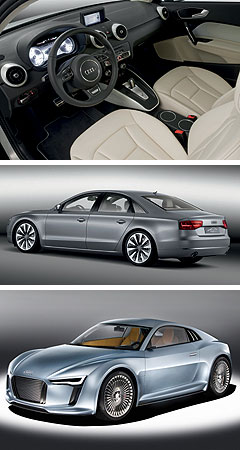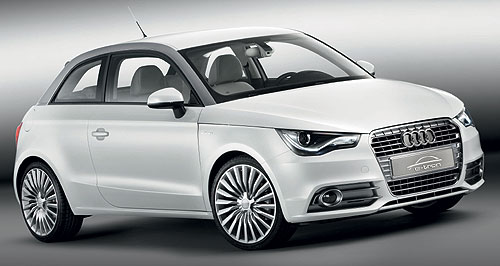Future models - Audi - A1Geneva show: Audi unveils plug-in A1 hybridPlugged in: A1 e-Tron concept heralds an extended-range hybrid version of Audi's all-new A1. Volkswagen’s luxury brand previews plug-in A1, confirms hybrid Q5, A82 Mar 2010 AFTER consistently dismissing hybrid and electric vehicle technology in preference for the economy of its existing diesel engines, Audi has now confirmed it will head directly down EV avenue by producing a plug-in hybrid version of its brand-new A1 micro and hybrid iterations of its Q5 SUV and A8 limousine. Audi first signalled its long-awaited shift towards EVs at the Frankfurt motor show last September, when its e-Tron eco-supercar concept heralded a “top-down” approach to vehicles powered exclusively by electricity. Now Audi has turned that strategy on its head too by announcing the A1 e-tron, a plug-in hybrid version of its brand-new A1 city-car, which also makes its world public debut at this week’s Geneva motor show and will rival the likes of BMW’s Mini, Fiat’s 500 and Alfa Romeo’s Mito in Europe from late this year. Also making its global premiere at the Swiss show is Audi’s A8 hybrid ‘engineering study’ which, in a move that will further depart from Audi’s previously stated position, will morph into a production car available to order in Europe from late 2011. On the eve of the 80th Geneva expo, Audi also confirmed it will release its first petrol-electric model before then, with a hybrid version of the mid-size Q5 crossover due to hit European showrooms later this year or in early 2011. Neither hybrid model has been confirmed for Australia and while the all-new RS5, which also debuts at Geneva, and petrol and diesel versions of the new A1 three-door have been unofficially confirmed for local release in late 2010 and early 2011 respectively, it is the image-leading A1 e-Tron concept that will take pride of place at Geneva. While a small production run for Audi’s all-new electric sports coupe, the e-Tron, which will become Audi’s brand name for all future EVs, has been confirmed for European release in late 2012, the A1 e-Tron ‘design study’ is not yet officially destined for production. However, Audi says the A1-based show car demonstrates that its expertise in electric drive systems extends down to the sub-compact vehicle segment and has confirmed it will expand its e-Tron model family step by step. Audi describes the A1 e-Tron as a “Mega City Vehicle (MCV)”, in reference to its suitability to cities with more than 10 million inhabitants, primarily in the US, Europe, Asia and South America. Unco-incidentally, ‘Megacity’ is also the working title of an all-new micro-car BMW has committed to releasing under a new sub-brand globally by around 2013. While the original R8 coupe-styled e-Tron concept had electric motors for all four wheels, the follow-up “near-series high-performance sportscar” shown at the Detroit motor show in January was a compact two-seater with two electric motors for each rear wheel.  Audi A1 e-Tron interior (top), A8 hybrid concept (centre) and e-tron Detroit concept (bottom).Similar in concept but not execution, the four-seat A1 e-Tron has an electric-only driving range of “more than 50km in city traffic”, but like General Motors’ Volt – to be sold here in 2012 as a Holden – the A1 e-Tron concept is actually a plug-in hybrid, because it employs a single-rotor rotary engine to recharge its battery once depleted. Audi A1 e-Tron interior (top), A8 hybrid concept (centre) and e-tron Detroit concept (bottom).Similar in concept but not execution, the four-seat A1 e-Tron has an electric-only driving range of “more than 50km in city traffic”, but like General Motors’ Volt – to be sold here in 2012 as a Holden – the A1 e-Tron concept is actually a plug-in hybrid, because it employs a single-rotor rotary engine to recharge its battery once depleted.As with GM and its Volt, Audi describes the compact combustion engine as a “range extending” electric car because it drives its (front) wheels at all times via electric power but eliminates the bugbear of traditional EVs – “range anxiety” – by providing an additional 200km of driving. According to Audi, the A1 e-Tron is fun to drive because its electric motor has a peak power output of 75kW and maximum torque of 240Nm, which is on par with the most powerful A1 variant expected from launch, the 78kW 1.2 TSI, with 45kW and 150Nm continuously available. But it can also return fuel consumption of just 1.9L/100km and CO2 emissions of just 45g/km, “according to the draft standard for determining the fuel consumption of range-extender vehicles”. Calculated using a similar formula, GM says the mid-size Volt lift-back can return 1.2L/100km. The A1 e-Tron incorporates a single-speed transmission (operated by a three-position 'gearshifter' fron the e-tron coupe), a regenerative braking system, electro-hydraulic steering from the regular A1 and, like the Volt, a T-shaped lithium-ion battery pack mounted below the floor, within both the transmission tunnel and in front of the rear axle in place of the fuel tank. The 380-volt Li-Ion battery comprises 96 prismatic cells, weighs less than 150kg and has a nominal energy content of 12 kiloWatt hours. Audi says other engine ‘concepts’ are possible, but the compact, lightweight (70kg) and “vibration-free” Wankel engine – mounted below the cargo floor – delivers 15kW of electric power, has a chamber volume of 254cc and runs at a constant 5000 rpm. Fed by a 12-litre fuel tank, it can be switched on or off as necessary by the driver, of left in full automatic mode. Painted in a special ‘Aqua Mint pearl effect’ tint and wearing 18-inch alloy wheels with 215/35 R18 tyres, Audi’s Geneva show star is said to weigh just 1190kg and reach 100km/h in 10.2 seconds, on its way to a top speed of 130km/h. Audi AG chairman Rupert Stadler said his company would pursue a strategy of introducing (EV) technology where it is appropriate for specific model lines and markets. “In future our customers will be able to choose from an increasingly broad range of driveline technologies,” he said. “To accompany our high-efficiency TDI and FSI engines, we shall offer electric power in the best possible forms for a wide range of mobility needs. The hybrid driveline will be followed by all-electric vehicles. “Just as ‘quattro’ has become a synonym for all-wheel drive, so ‘e-Tron’ is to be the Audi brand name for electric mobility,” said Mr Stadler. Audi technical development chief Michael Dick said plug-in hybrids would be better suited to long-distance motoring than pure EVs. “We regard the full hybrid as we know it today primarily as a very specific technology for reducing fuel consumption. In due course plug-in hybrids will demonstrate their strong points when drivers expect to cover longer distances in the pure electric mode, in combination with a conventional engine,” he said. “The strength of the electric car clearly lies in the urban mobility area, where the demand for emission-free local transportation will strongly increase.” Moving even further beyond its hitherto exclusively petrol and diesel engine technologies, Audi says it “continues to develop its long-term competence in the development of basic propulsion concepts using fuel cells and hydrogen as an energy carrier. Including internal combustion engine development, Audi says it invests around two billion Euro ($A3.02b) annually to develop technologies including hybrid, fuel cell and hydrogen systems. Audi says it has strategically grouped together such EV programs under the banner of its “e-performance project house”, in which a team has worked since 2009 with support from the Federal German Ministry for Education and Research. “Electric mobility is a further priority: In this area the e-Tron show car seen at the (Frankfurt) IAA was a dramatic signal. At the same time, the various activities are being grouped together strategically. “Audi has established the e-performance project house to deal with electric mobility topics. Since the autumn of 2009 a team has been at work on the research project of the same name. “Members of the team, consisting of Audi AG development staff and scientists from various universities, are working on the development of a new overall electric vehicle concept, including the body, battery and power electronics.” For now, Audi claims that with average fuel consumption of 6.2L/100km and CO2 emissions of 144g/km, its A8 hybrid engineering study at Geneva is cleaner than full-size luxury sedan rivals from BMW, Mercedes-Benz and Lexus. It combines a 155kW 2.0 TFSI four-cylinder petrol engine with a 33kW electric motor in a full parallel hybrid system that delivers a combined output of 180kW and 480Nm – comparable with a large-capacity conventional six-cylinder engine. Also incorporating an eight-speed automatic transmission, Audi says the A8 hybrid can travel for up to 2km and at speeds of up to 65km/h in all-electric mode.  Read more25th of February 2010  Geneva show: A1 to take aim at Audi adversariesAudi announces rock star reveal for A1, alongside RS5, A8 Hybrid and Geneva surprise15th of February 2010  A1 to multiply Audi salesIngolstadt’s Mini rival will max out Audi market share with a multitude of variantsAll future models Alfa Romeo Alfa Romeo Abarth Abarth Audi Audi Aston Martin Aston Martin BMW BMW Bentley Bentley Chrysler Chrysler Chevrolet Chevrolet Dodge Dodge Citroen Citroen Ferrari Ferrari DS DS Ford Ford Fiat Fiat FPV FPV Foton Foton Haval Haval Great Wall Great Wall Honda Honda Holden Holden Hyundai Hyundai HSV HSV Isuzu Isuzu Infiniti Infiniti Jeep Jeep Jaguar Jaguar Lamborghini Lamborghini Kia Kia Lexus Lexus Land Rover Land Rover Mazda Mazda Maserati Maserati Mercedes-Benz Mercedes-Benz McLaren McLaren Mini Mini Nissan Nissan Mitsubishi Mitsubishi Peugeot Peugeot Opel Opel Proton Proton Porsche Porsche Renault Renault Ram Ram Saab Saab Rolls-Royce Rolls-Royce Smart Smart Skoda Skoda Subaru Subaru SsangYong SsangYong Tesla Tesla Suzuki Suzuki Toyota Toyota Volvo VolvoA1 pricing
Motor industry news |
Click to shareAudi modelsResearch Audi All future models Alfa Romeo Alfa Romeo Abarth Abarth Audi Audi Aston Martin Aston Martin BMW BMW Bentley Bentley Chrysler Chrysler Chevrolet Chevrolet Dodge Dodge Citroen Citroen Ferrari Ferrari DS DS Ford Ford Fiat Fiat FPV FPV Foton Foton Haval Haval Great Wall Great Wall Honda Honda Holden Holden Hyundai Hyundai HSV HSV Isuzu Isuzu Infiniti Infiniti Jeep Jeep Jaguar Jaguar Lamborghini Lamborghini Kia Kia Lexus Lexus Land Rover Land Rover Mazda Mazda Maserati Maserati Mercedes-Benz Mercedes-Benz McLaren McLaren Mini Mini Nissan Nissan Mitsubishi Mitsubishi Peugeot Peugeot Opel Opel Proton Proton Porsche Porsche Renault Renault Ram Ram Saab Saab Rolls-Royce Rolls-Royce Smart Smart Skoda Skoda Subaru Subaru SsangYong SsangYong Tesla Tesla Suzuki Suzuki Toyota Toyota Volvo VolvoA1 pricing
Motor industry news |
















Facebook Twitter Instagram